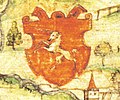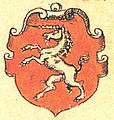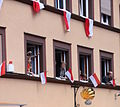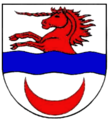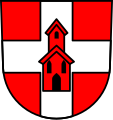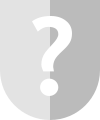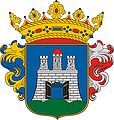Coat of arms of the city of Schwäbisch Gmünd
|
Large district town Schwäbisch Gmünd Ostalbkreis |
|
|---|---|
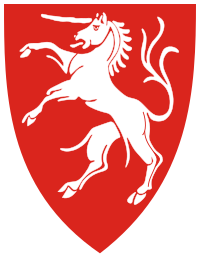
|
|
| Blazon | |
|
|
| City colors and flag | |
| White-red | |
| Basic data | |
| Introduction: | 13th Century |
| Legal basis: | Seal guide: occupied since February 3, 1277 |
| Supporting documents: | The coat of arms is handed down in the seal. |
| Former municipalities with their own coat of arms: |
Bargau , Bettringen , Degenfeld , Großdeinbach , Herlikofen , Lindach , Rechberg , Straßdorf , hamlets in the mountains |
The coat of arms of the city of Schwäbisch Gmünd shows in the red shield an upright silver unicorn heraldically turned to the right . It is one of the oldest city coats of arms in Baden-Württemberg . The oldest representation of the coat of arms comes from an imprint of a seal on a document from 1277. Since then, Schwäbisch Gmünd has been using the ascending, right-facing unicorn as the coat of arms, which over time only slightly adapts to the current zeitgeist. The coat of arms was first shown in color in 1480.
history

The oldest depiction of the Schwäbisch Gmünd city coat of arms comes from an imprint of a seal on a document dated February 3, 1277. In it, a Heinrich Pfau sells his property in Burgholz to the Spital zum Heiligen Geist in Schwäbisch Gmünd. The sale was certified with the seal of the citizens of Gmünd. This seal imprint, a so-called triangular seal, shows the Gmünder unicorn in the middle of a simple shield. The escutcheon is framed with the words "+ S. C (I) VIUM (DE) (GA) MUN (DI) A". Due to the shape of the shield, it is assumed that the seal image was created around 1250 or at least under the rule of the Hohenstaufen .
From 1414 an angel appeared as a shield holder , as he z. B. is shown on the west facade of the Schwörhaus . The seal inscription read "SIGILLVM SECRETVM C * GAMVNDIENSIVM". With a few exceptions, the angel was used as a shield holder until the end of the imperial city period in 1802. It is not known why the city got an angel as a shield holder.
At the beginning of the 16th century, a mountain was added as a shield base on which the unicorn is depicted. Sometimes the unicorn was also placed on a floor. It remained on the city's seals until the early 20th century.
The unicorn coat of arms also served the guilds of the Free Imperial City as a calibration and inspection mark for export goods. Counterfeiting of this trademark was prosecuted and prosecuted. In 1446, a Hainz gentner from Schwäbisch Gmünd was punished with life-long expulsion from the city, because he had identified several honey barrels with the unicorn as calibrated, but made them smaller.
The coat of arms of the unicorn is mentioned in a certificate from Constance dated August 1, 1507. Is therein by I. Maximilian "again an old tradition" confirmed and protected Sensen prepared in Schwäbisch Gmünd and tested to identify the "arms of the freyen Eingehüren". A sample of these hallmarks is no longer available.
In addition to the actual city coat of arms, Schwäbisch Gmünd also carried the coat of arms eagle of the empire as a sign of its imperial immediacy . In contrast to other imperial cities, such as in neighboring Aalen or in Bopfingen , the Gmünder coat of arms was mostly free and was only rarely placed on the eagle as a heart shield .
The design used today was created around 1960 by the Stuttgart painter Immanuel Knayer (1896–1962), who designed numerous municipal coats of arms in Baden-Württemberg . The unicorn coat of arms comes from the Herlikofen district of Knayer.
symbolism
It is not known where the unicorn came from as a heraldic animal for the city and who created it. It is also not known what ideological significance it had for the citizens of the city.
Since the neighboring imperial city of Giengen , whose seal coat of arms of the same figure has been documented since 1293, also has a unicorn, a connection to the Hohenstaufen, z. B. via a ministerial , considered possible. The Rauchbein Chronicle, named after Mayor Hans Rauchbein († 1563), from the middle of the 16th century states that the coat of arms was awarded by the Hohenstaufen dynasty .
According to the legend that a unicorn can only be caught by an innocent virgin, it stands in heraldry as a symbol of Christ and the purity and virginity of Mary. It is also a symbol of purity and virtue. Mainly in English heraldry, it also embodies royal jurisprudence.
The geologist Winfried Trinkle saw the unicorn as an aurochs as heraldic animal , since the horns in Assyrian or Babylonian representations overlap and appear like a horn. After these animals became extinct, the images were misinterpreted as unicorns.
Regardless or ignorance on heraldic representations of local historian looked Theodor Zanek in Seal picture of 1277 due to the similarity of the horn with a deer antler a stag . He considered a direct connection to the founding legend of Schwäbisch Gmünd to be conceivable. This theory is generally dismissed as a curiosity. As early as 1976, Eugen Banholzer noticed that although the horn would look like a deer, this only shows how attempts were made in contemporary portrayals to create the appearance of the unknown unicorn using the horns of known animals.
City colors
In 1913 a colored image with the coat of arms and flag was discovered on a panel painting in the Grät . Based on an existing description, these could be clearly assigned to the year 1480. It is the oldest known color representation of the coat of arms and the city colors. Red and white are common colors of imperial cities. According to Banholzer, these colors were recommended for Gmünd because they are the oldest imperial colors. The city's field banner, newly awarded by Emperor Maximilian on April 21, 1505, also shows white over red.
In Wapen published in 1545 . Of the Holy Roman Empire Teutscher nation. by Jacob Kallenberg and Jacob Köbel the tincture "Weis Aynhorn in Rottem field" is specified for the standard-bearer of "Schwebisch Gemind".
Despite occasional variations and color errors, the colors red and white remained unchanged as the city colors of Schwäbisch Gmünd. In the work Deutsche Wappen , published in 1971, it is claimed that "in the colored representations since the middle of the 15th century, the unicorn has mostly been gold, but since the beginning of the 17th century (Sibmacher 1605), silver has been preferred". Contemporary sources, on the other hand, do not know of a golden unicorn. According to the Rauchbeinschen Chronik , the city coat of arms was a "white aingehurn in a red field" as long as it existed.
In the work Deutsche Ortswappen for Gmünd , published after 1925, the renowned heraldist Otto Hupp stated “a golden-armored silver unicorn in red” without specifying a source.
The city flag without coat of arms is freely available to citizens. Even if the unicorn coat of arms is only reserved for the city, its use by private individuals is generally tolerated or at least not punished, provided that no abuse is committed.
Heraldic art
In the past and present, the Gmünder coat of arms found its way into art, on house facades or on fountains and boundary stones.
The city of Schwäbisch Gmünd dedicated an exhibition to the mythology of its heraldic animal. In the exhibition presentation held from November 12, 1999 to March 5, 2000, “The Unicorn. Mythos und Signet ”, works by Albrecht Dürer , Hans Baldung Grien and Matthäus Merian were shown. In addition, the seal of 1277 was issued. The sculptor Anatol Herzfeld created a unicorn sculpture especially for the exhibition.
Coat of arms on the town hall
Everyday culture
Companies, associations and private individuals also use unicorns and coat of arms colors and use the Gmünder symbols in words and images as a means of identification. Sometimes the English spelling unicorn is used for the unicorn. The coat of arms is used in numerous advertising materials and souvenirs.
Companies
The unicorn appeared as a company logo in the Gmünder silver goods industry. B. at the silverware manufacturer Gebrüder Kühn and the ring and jewelery factory LC Köhler .
The Einhorn-Verlag in Schwäbisch Gmünd borrowed the company name and logo from the Gmünder heraldic animal. In addition, the magazine einhorn was published by the publishing house from 1953 to 1973 , and ostalb einhorn from 1974 to 2010 . The publisher has been publishing the unicorn yearbooks since 1974 .
During the imperial city period, a pharmacy in Schwäbisch Gmünd was temporarily called the Einhorn-Apotheke . Even today, a pharmacy and a hotel bear the name Einhorn . More recently, the name unicorn existed for a restaurant.
Since the Rems-Zeitung also takes on public tasks by publishing official announcements for the city of Schwäbisch Gmünd, the city's coat of arms has been featured on the front page since the late 19th century.
societies
In 2000/01, 1. FC Normannia Gmünd briefly had a modernized club coat of arms with a stylized red unicorn similar to the city logo, before returning to the traditional coat of arms. The club colors of the "Normans" are black and red, but the club coat of arms shows the Gmünd city colors white and red.
The gymnastics community Schwäbisch Gmünd , one of the predecessor clubs of TSB Schwäbisch Gmünd , used the unicorn as the club's coat of arms.
The dance club Rot-Weiss Gmünd holds an annual competition for the unicorn cup.
The numerous peer groups also use red and white, with or without a unicorn, as a logo. The umbrella organization of Schwäbisch Gmünder peers' associations uses the city coat of arms in the reverse color sequence.
Furthermore, the Gmünder symbols are used inter alia in the logos of the Gmünder Historical Association , the Kolpingkapelle , the first Musikverein town band , the Guggenmusik profit mutual Gmendr Gassafetza and Gmendr Altstadtfäger or the working group Alt-Gmund use. Die Einhorn-Musikanten , the running community Die Einhörner and the Unicorn Promenaders Square Dance Club have named themselves after the Gmünder heraldic animal.
A unicorn was repeatedly used on the finisher medals of the Albmarathon , or on the medals and certificates of the Gmünder Sport-Spiel-Fun , an annual school sporting event.
Others
The approximately 2.2 km long tunnel on federal road 29 (B 29) through Schwäbisch Gmünd was named Gmünder Einhorn-Tunnel in October 2011 .
In the district Straßdorf is Unicorn street named after the Gmünder emblem.
The logo of the State Garden Show 2014 also draws on the unicorn.
Coats of arms of the districts
Apart from Hussenhofen (former part of the municipality of Herlikofen) and Wetzgau (former part of the municipality of Großdeinbach), today's districts, as independent municipalities, had their own coats of arms and sometimes a municipality flag. The former municipality of Rechberg had had its coat of arms since 1919, while Bettringen's coat of arms in its current design was only officially valid from 1957 to 1959. These symbols have ceased to exist as official symbols with the respective incorporation, but are still used by the city and the city districts. They are used, among other things, on welcome boards or on flags on festive occasions.
All coats of arms of the former municipalities refer with their coat of arms pictures and / or the coat of arms colors to the affiliation to former rulers. The imperial city of Schwäbisch Gmünd (in the coats of arms of Bettringen, Herlikofen, Straßdorf and Weiler in the mountains) and Rechberg (in the coats of arms of Bargau, Bettringen, Großdeinbach and Rechberg) dominate. Borrowings were also taken from the coats of arms of the Staufer (Herlikofen), Württemberg (Lindach) and the Spital zum Heiligen Geist (bed rings). The coat of arms of Degenfeld is, apart from the two arrows, identical to the family coat of arms of the noble family of the same name.
In addition to the patriarchal cross in the Bettring coat of arms, the attributes of the local saints appear as symbols with a religious background in the coat of arms of Degenfeld and Weiler in the mountains.
The coats of arms of Lindach, Rechberg and Weiler in the mountains are regarded as "talking" .
Hussenhofen (2000) and Rehnenhof-Wetzgau (2009) received their symbols (“coat of arms”) only recently.
| coat of arms | district | Incorporated | description | flag | Introduced |
|---|---|---|---|---|---|
 |
Bargau | 1st January 1971 | Blazon: In silver an upright red lion, holding a blue ploughshare in his front paws . As a reminder of the time when Bargau was part of the Rechberg region, the district bears the coat of arms of the Counts of Rechberg, a red lion on a silver background with an overturned blue ploughshare in its front paws. |
White-red | 1956 |
 |
Bed rings | April 1, 1959 | Blazon: In a split shield in front in silver (white) a red lion turned to the right , behind in red a silver (white) double cross . The double cross reminds of the hospital in Schwäbisch Gmünd, the lion refers to the Lords of Rechberg . The colors red and white are based on the city colors of Schwäbisch Gmünd. |
Red White | November 29, 1957 |
 |
Degenfeld | 1st January 1971 | Blazon: Two crossed arrows in alternating colors above the blue base of the shield in a red and silver quartered shield . Since Degenfeld was the ancestral seat of the Lords of Degenfeld , the coat of arms shows the Degenfeld family coat of arms . The symbol, the crossed arrows, stand for the local saint Sebastian . |
White-red | 2nd February 1957 |
 |
Großdeinbach | March 1, 1972 | Blazon: In gold, a red tulip on a green stem with four green leaves . The colors red and gold are the house colors of the Rechberg house . The meaning of the tulip has not been passed down, possibly it should be an indication of the status of Großdeinbach as a climatic health resort at that time. |
Red Yellow | 1938 |
 |
Herlikofen | 1st January 1969 | Blazon: In a split shield in front in gold a black lion, behind in red a silver unicorn turned to the left . The black lion on a golden background stands for the imperial family of the Staufer , the silver unicorn for Schwäbisch Gmünd. The design for the coat of arms comes from the Stuttgart painter Immanuel Knayer . |
White-red | December 11, 1957 |
 |
Hussenhofen | 1st January 1969 | Blazon: a rooster striding in gold . The rooster is a common figure and alludes to the local neck name Rems göckel as a talking coat of arms . The coat of arms signet was designed by Hussenhöfer Hermann Kugler . |
White-red | 2000 |
 |
Lindach | July 1, 1971 | Blazon: A black floating linden tree with roots in gold . The coat of arms symbol of the linden tree stands as a talking coat of arms for the place. The colors black and gold show Lindach's earlier membership in the court chamber of the House of Württemberg . Lindach is the only district of Gmünd that has neither white nor red as coat of arms or flag colors. |
black yellow | 1955 |
 |
Rechberg | 1st January 1975 | Blazon: In gold on a green mountain a striding red roebuck . The red roebuck comes from the coat of arms of the Counts of Rechberg-Rothenlöwen and, in connection with the green mountain, is a talking coat of arms . Red and gold are the colors of the Rechberg house. |
Red Yellow | 1919 |
 |
Rehnenhof-Wetzgau | April 1, 1938 | The coat of arms signet shows the three churches of the village on a silver background in the split shield in front , as they are also depicted on the welcome signs. At the back the Gmünder unicorn can be seen in logo form. | Red White | July 17, 2009 |
 |
Strassdorf | March 30, 1972 | Blazon: In a split shield in front in silver a soaring red lion turned to the left, in the back three silver bars in red . The red lion on a silver background is a reference to the Counts of Rechberg-Rothenlöwen , red and silver are the colors of the coat of arms of Schwäbisch Gmünd. |
White-red | 1954 |
 |
Hamlet in the mountains | 1st January 1971 | Blazon: In red over a green six-mountain, a silver scale . The mountain in the coat of arms stands for the place name suffix "in the mountains". The scales are an attribute of the local saint, the Archangel Michael . The colors red and silver come from the coat of arms of Schwäbisch Gmünd. |
White-red | 1958 |
More coats of arms
The coat of arms of the city of Giengen an der Brenz , first documented in 1293, only differs from the coat of arms colors. A connection to the coat of arms of the city of Schwäbisch Gmünd and the Hohenstaufen imperial family is sometimes assumed.
The Baldung family , who came from Schwäbisch Gmünd and emigrated to Alsace, had a unicorn trunk as their coat of arms as a sign of their origin. The coats of arms of the most famous family member, Hans Baldung Grien, are well known .
From April 19, 1955 to January 1, 1973, the former district of Schwäbisch Gmünd had a soaring, black, red-tongued lion in a golden shield. In the coat of arms awarded by the Ministry of the Interior of Baden-Württemberg, the lion stood for the earlier affiliation of the majority of the district area to the Hohenstaufen property.
In Lautern's coat of arms , the growing, red unicorn was a direct reference to the earlier affiliation of the municipality, which was incorporated into Heubach in 1971, to the imperial city of Schwäbisch Gmünd. The coat of arms, extended by the crescent moon from the coat of arms of the noble family Woellwarth-Hohenroden , was adopted in 1957.
The use of the colors red and silver in the coats of arms of the neighboring communities Mutlangen (introduced in 1954) and Iggingen (introduced in 1957) was explicitly chosen because of the earlier affiliation of these communities to the imperial city of Gmünd.
The only room in Gmünd that belongs to Hussenhofen has a coat of arms, which, however, is not displayed on a flag on official occasions. The carpenter's hatchet as a speaking part of the coat of arms refers to the place name Zimmer, the three spheres come from the coat of arms of the Gmünd patrician family Kurz , who owned Zimmer in the 14th century.
Coats of arms and seals of the twin cities
 Antibes (France)
Antibes (France)
 Barnsley (United Kingdom)
Barnsley (United Kingdom)
 Bethlehem, PA (United States)
Bethlehem, PA (United States)
 Faenza (Italy)
Faenza (Italy)
 Székesfehérvár (Hungary)
Székesfehérvár (Hungary)
Coat of arms similarities
Although one essence of heraldry is that each coat of arms is unmistakable and unique, there are local coats of arms in German-speaking countries that are similar to the coat of arms of Schwäbisch Gmünd.
Former coat of arms of Tengen
literature
- Richard Schall: The official coats of arms and flags in the district of Schwäbisch Gmünd , in einhorn - Illustrated magazine to cultivate the idea of home and to promote tourism in the city and district of Schwäbisch Gmünd, No. 33, Einhorn-Verlag Eduard Dietenberger, Schwäbisch Gmünd, February 1959, Pp. 17-21.
- Eugen Banholzer: The “White Unicorn in a Red Field”. From the coat of arms of the city of Schwäbisch Gmünd , in einhorn-Jahrbuch Schwäbisch Gmünd 1975, Einhorn-Verlag Eduard Dietenberger KG, Schwäbisch Gmünd, 1975, pp. 169-189.
- Klemens Stadler: German coat of arms. Federal Republic of Germany, Volume 8: The municipal coats of arms of the federal state of Baden-Württemberg . With drawings by Max Reinhart. Angelsachsen-Verlag Bremen, 1971.
- Heinz Bardua: The communal coat of arms of the Ostalb district . Ostalb-Einhorn 10 (1983), pp. 75-88.
- Heinz Bardua: District and community arms in Baden-Württemberg. Volume 1: The district and community coats of arms in the Stuttgart administrative region . Landesarchivdirektion Baden-Württemberg (ed.), Konrad Theiss Verlag Stuttgart, 1987, ISBN 3-8062-0801-8 .
- Landesdenkmalamt Baden-Württemberg (ed.): The art monuments in Baden-Württemberg. City of Schwäbisch Gmünd, Volume I: City history, city fortifications, Heiligkreuzmünster . Deutscher Kunstverlag, Munich / Berlin 2003, ISBN 3-422-06381-1 , p. 56f.
- Klaus Jürgen Herrmann : The unicorn as heraldic animal of the city of Schwäbisch Gmünd , in: Werner HA Debler and Klaus Jürgen Herrmann: The Chronicle of Dominikus Debler (1756–1836) - City history in pictures , Einhorn-Verlag, Schwäbisch Gmünd, 2006, ISBN 978- 3-936373-25-7 , p. 87
- Ann-Kathrin Rothermel: Unicorn, Lime Tree and Three Churches , in: Gmünder Tagespost from August 12, 2009.
See also
Web links
References and comments
- ↑ Hussenhofen , Rehnenhof-Wetzgau and Zimmer have coats of arms given by the city of Schwäbisch Gmünd, but were never independent communities
- ↑ Stadler, p. 9
- ↑ German: "Seal of the Citizens of Gmünd". Bracketed letters are no longer preserved in the original
- ^ Albert Deibele : An archival treasure. The oldest document in the Gmünder Stadtarchiv , in: einhorn - Illustrated magazine for cultivating the idea of home and promoting tourism in the city and district of Schwäbisch Gmünd, No. 17, Einhorn-Verlag Eduard Dietenberger, Schwäbisch Gmünd, June 1956, p. 87
- ↑ See Stadler
- ↑ See KJ Herrmann
- ↑ Banholzer, p. 179
- ^ Ottfried Neubecker : Heraldry. Coat of arms - their origin, meaning and value , Wolfgang Krüger Verlag, Frankfurt am Main, 1977, ISBN 3-8105-1306-7 , p. 116
- ^ DL Galbreath and Léon Jéquier: Handbuch der Heraldik , Battenberg Verlag, Augsburg, 1990, ISBN 3-89441-259-3 , p. 285
- ^ Walter Leonhard : The great book of heraldic art. Development, elements, motifs, design. 2nd, revised and expanded edition. Georg DW Callway, Munich 1978, ISBN 3-7667-0345-5 , p. 243f.
- ↑ Winfried Trinkle: The geology in the district of Schwäbisch Gmünd . Konrad Theiss Verlag, Stuttgart, 1972, ISBN 3-8062-0109-9 , p. 74
- ↑ Theodor Zanek: Unicorn or Deer? The tradition of founding the town as a program of images for the Johanniskirche zu Schwäbisch Gmünd , in: ostalb einhorn. Quarterly books for home and culture in the Ostalbkreis, No. 54, Ostalbverlag - Schwäbischer Heimatverlag Dietenberger & Theiss GmbH & Co., Aalen, June 1987, pp. 156–161
- ↑ Cf. Die Kunstdenkmäler in Baden-Württemberg, Volume I , p. 56
- ↑ Eugen Banholzer: The "White Unicorn in a Red Field". II. The coat of arms of Schwäbisch Gmünd a picture of the occidental unicorn , in einhorn yearbook 1976, Einhorn-Verlag Eduard Dietenberger GmbH, Schwäbisch Gmünd, 1976, p. 174
- ↑ Banholzer, p. 179
- ↑ Banholzer, p. 178
- ↑ Quoted from Stadler, p. 94
- ↑ Banholzer, p. 182
- ↑ Quoted from Banholzer, p. 178
- ^ Otto Hupp : German coat of arms. Württemberg , Kaffee Hag, n.d. (after 1925)
- ^ City of Schwäbisch Gmünd: The unicorn. Myth and Signet
- ↑ Exemplary examples ( Memento of the original dated December 13, 2013 in the Internet Archive ) Info: The archive link was inserted automatically and has not yet been checked. Please check the original and archive link according to the instructions and then remove this notice.
- ↑ Rot-Weiss-Ball: Feelings, Colors, Music and Dance in Harmony in Rems-Zeitung from November 26, 2012
- ↑ Overview of peers' associations on the website of the city of Schwäbisch Gmünd, partly with a preview function of the logos
- ↑ Internet presence of the umbrella organization of Schwäbisch Gmünder Peer Associations ( Memento of the original from June 24, 2013 in the Internet Archive ) Info: The archive link was inserted automatically and has not yet been checked. Please check the original and archive link according to the instructions and then remove this notice.
- ↑ As a district of Herlikofen
- ↑ Awarded by Mayor Gerhard Rembold
- ↑ Wetzgau district from Großdeinbach to Schwäbisch Gmünd. The Rehnenhof homestead had belonged to Schwäbisch Gmünd since 1419
- ↑ Determined by the district advisory board
- ↑ Klaus Jürgen Herrmann: The coat of arms of rooms and its interpretation . In: Werner Ritzer: “Rooms, City of Schwäbisch Gmünd. The history of a village in words and pictures ”, published by the 1150 Years Rooms Working Group, Schwäbisch Gmünd, 1989

